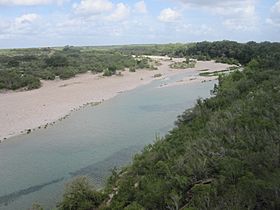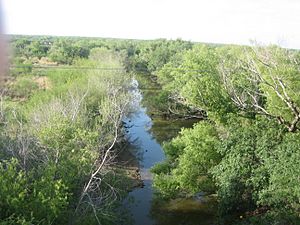Nueces River facts for kids
Quick facts for kids Nueces River |
|
|---|---|

U.S. Highway 83 crosses the Nueces River in northern Zavala County between La Pryor and Uvalde, Texas.
|
|

Nueces River watershed
|
|
| Native name | Chotilapacquen |
| Other name(s) | Río de la Nueces |
| Country | United States |
| State | Texas |
| Physical characteristics | |
| Main source | Edwards Plateau |
| River mouth | Corpus Christi Bay Nueces County, Texas |
| Length | 315 mi (507 km) |

The Nueces River is a long river in Texas, USA. It flows for about 315 miles (507 km). This river helps drain water from central and southern Texas into the Gulf of Mexico. It's the main river in southern Texas, just northeast of the Rio Grande. The name Nueces means "nuts" in Spanish. Early settlers gave it this name because of the many pecan trees growing along its banks.
Contents
Journey of the Nueces River
The Nueces River begins in the Edwards Plateau in Real County. This area is northwest of San Antonio. It starts about 50 miles (80 km) north of Uvalde.
Flowing Through Texas
The river flows south through the beautiful Texas Hill Country. It passes towns like Barksdale and Crystal City. At one point, it gets very close to the Rio Grande river, which is the border with Mexico.
East of Carrizo Springs, the Nueces River turns east. It flows through the flat, brushy plains of South Texas. It crosses through Dimmit, La Salle, and McMullen Counties.
Meeting Other Rivers
In Live Oak County, the Nueces River meets two other rivers. The Atascosa River and the Frio River join it at a place called Three Rivers. After this, the Nueces flows southeast towards the coast.
It passes Mathis, where a dam creates Lake Corpus Christi. This lake is a large reservoir. Finally, the Nueces River flows into Corpus Christi Bay at Corpus Christi, reaching the Gulf of Mexico.
History of the Nueces River Area
The Nueces River has a rich history. Native American groups, like the Coahuiltecan people, called it Chotilapacquen.
Naming the River
The Spanish explorer Alonso de León was the first European to name the river "Nueces." He did this because of the many pecan trees he saw along its banks. Pecans are a type of nut, and "nueces" means "nuts" in Spanish.
Border Disputes and Wars
For a long time, the Nueces River was an important border. Before the Texas Revolution, Mexico believed the Nueces River was the border between its state of Tejas and the rest of Mexico.
However, after the Texas Revolution, the Republic of Texas claimed the Rio Grande as its border. This claim was based on a treaty signed by Mexican President Santa Anna. This disagreement continued when Texas joined the United States. It was one of the main reasons for the Mexican–American War.
The Treaty of Guadalupe Hidalgo ended this war. In this treaty, Mexico agreed that the Rio Grande would be its northern border.
Old Mines and a Sad Event
There have been stories about lost Spanish mines near the Nueces River since the early 1800s. These stories come from two missions built in the area in the mid-1700s.
A sad event happened near the river on August 10, 1862. During the American Civil War, a group of Germans from the Texas Hill Country who supported the Union tried to escape to Mexico. They were attacked and killed by Confederate soldiers in what is known as the Nueces massacre.
Wildlife and Fishing in the Nueces River
The Nueces River is one of several clear, warm-water rivers in the Texas Hill Country. In its upper parts, the water is very clear and cool.
Fish and Other Animals
The Nueces River is a great place for fishing. It is home to different types of fish, including:
- Largemouth bass
- Smallmouth bass
- The native Guadalupe bass
- Various panfish like redbreast sunfish, rock bass, green sunfish, and Rio Grande perch
The American alligator is also very common in the Nueces River.
See also
 In Spanish: Río Nueces para niños
In Spanish: Río Nueces para niños

